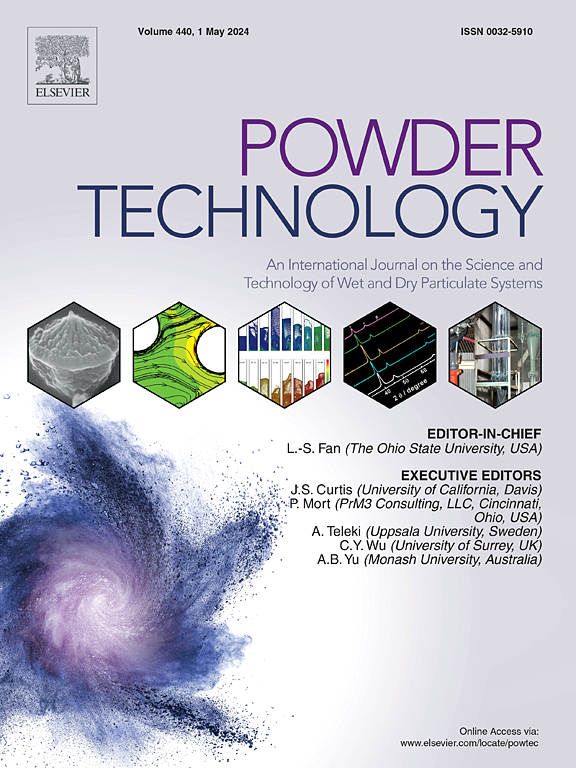Force analysis of bubble-particle detachment colliding with a solid surface
IF 4.5
2区 工程技术
Q2 ENGINEERING, CHEMICAL
引用次数: 0
Abstract
This is the second in a series of papers concerned with bubble-particle detachment colliding with a solid surface. Part I [22] explored, experimentally, the detachment of a particle from the surface of a bubble colliding with a solid surface in mimic of the pulp-froth interface. Detachment was seen to be dependent on interactions between the bubble-particle aggregate and the solid surface, which is characterized by the inclination angle. A neck was formed during the detachment process between a particle and a bubble. Zoom in images of bubble-particle aggregate are used to extract parameters on contact angle and three-phase contact, which can be used to calculate forces acting on the particle.
Part II presents calculations of the forces in the particle detaching processes, which is essential to the modelling of coarse particle flotation processes. It is found that advancing contact angle serves as a prerequisite for the particle detachment in both particle detachment modes, i.e. rebound detachment and slip detachment. The advancing contact angle makes the three-phase contact line contract and move over the location of the maximum capillary force. After which the particle is likely on the track of detachment.
This study provides detailed experimental observations and calculations of the forces acting on particles during separation, analyzes the forces between particles attached to bubbles when aggregates collide with a flat wall, and provides the first quantitative analysis of the impact of contact angle hysteresis on the separation mechanism, providing new insights for applications in the field of transportation and beneficiation.

气泡粒子与固体表面碰撞的脱落力分析
本文是关于气泡粒子与固体表面碰撞时脱离的系列论文的第二篇。第一部分[22]通过实验探索了粒子从气泡表面脱离的情况,气泡与固体表面碰撞时模拟了纸浆-泡沫界面。实验表明,脱离取决于气泡-颗粒聚合体与固体表面之间的相互作用,而这种相互作用以倾斜角为特征。在颗粒与气泡分离的过程中会形成一个颈部。气泡-颗粒集合体的放大图像用于提取接触角和三相接触参数,这些参数可用于计算作用在颗粒上的力。研究发现,在两种颗粒脱落模式(即反弹脱落和滑动脱落)中,推进接触角是颗粒脱落的先决条件。前进接触角使三相接触线收缩并移动到毛细管力最大的位置。本研究对分离过程中作用于颗粒的力进行了详细的实验观察和计算,分析了聚集体与平壁碰撞时附着在气泡上的颗粒之间的力,并首次定量分析了接触角滞后对分离机理的影响,为运输和选矿领域的应用提供了新的见解。
本文章由计算机程序翻译,如有差异,请以英文原文为准。
求助全文
约1分钟内获得全文
求助全文
来源期刊

Powder Technology
工程技术-工程:化工
CiteScore
9.90
自引率
15.40%
发文量
1047
审稿时长
46 days
期刊介绍:
Powder Technology is an International Journal on the Science and Technology of Wet and Dry Particulate Systems. Powder Technology publishes papers on all aspects of the formation of particles and their characterisation and on the study of systems containing particulate solids. No limitation is imposed on the size of the particles, which may range from nanometre scale, as in pigments or aerosols, to that of mined or quarried materials. The following list of topics is not intended to be comprehensive, but rather to indicate typical subjects which fall within the scope of the journal's interests:
Formation and synthesis of particles by precipitation and other methods.
Modification of particles by agglomeration, coating, comminution and attrition.
Characterisation of the size, shape, surface area, pore structure and strength of particles and agglomerates (including the origins and effects of inter particle forces).
Packing, failure, flow and permeability of assemblies of particles.
Particle-particle interactions and suspension rheology.
Handling and processing operations such as slurry flow, fluidization, pneumatic conveying.
Interactions between particles and their environment, including delivery of particulate products to the body.
Applications of particle technology in production of pharmaceuticals, chemicals, foods, pigments, structural, and functional materials and in environmental and energy related matters.
For materials-oriented contributions we are looking for articles revealing the effect of particle/powder characteristics (size, morphology and composition, in that order) on material performance or functionality and, ideally, comparison to any industrial standard.
 求助内容:
求助内容: 应助结果提醒方式:
应助结果提醒方式:


